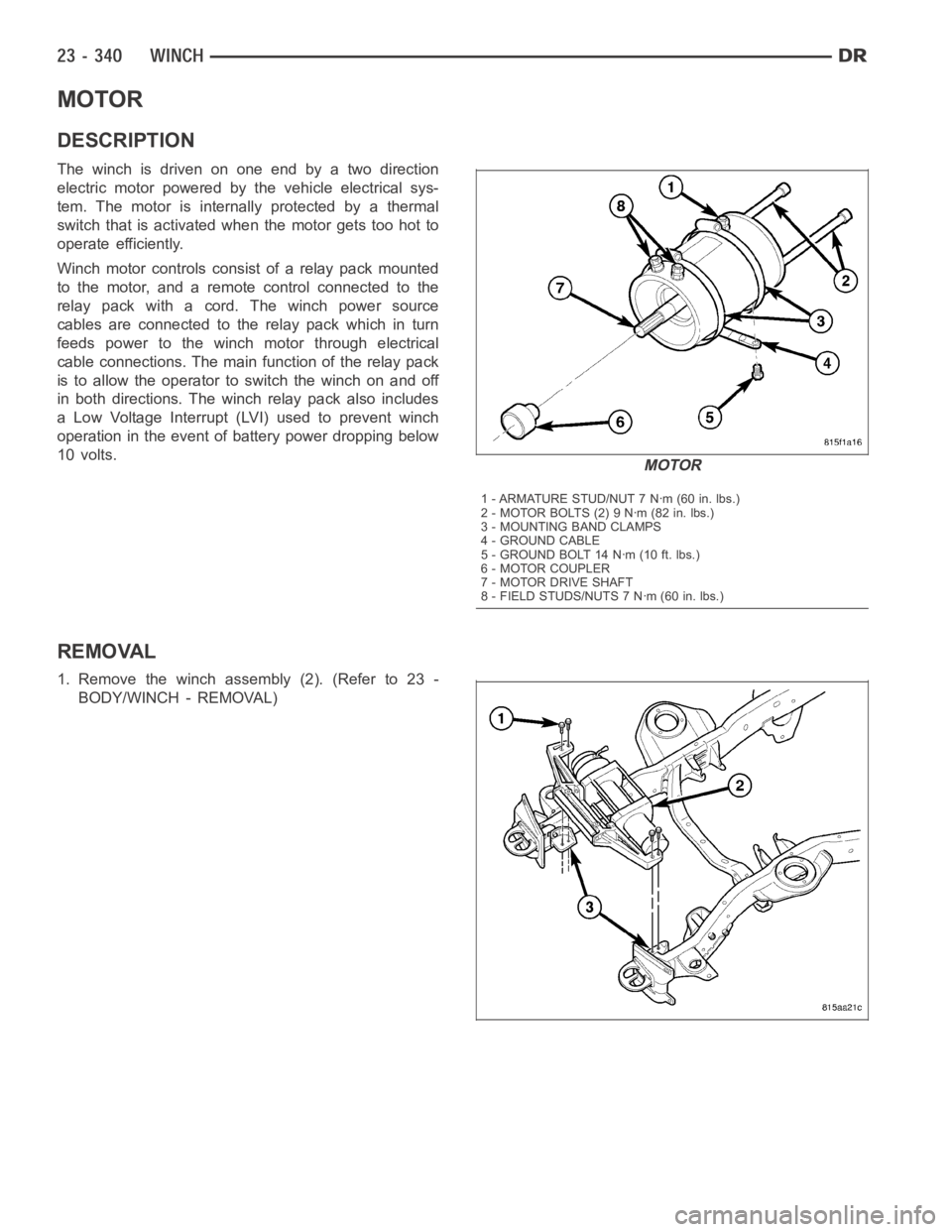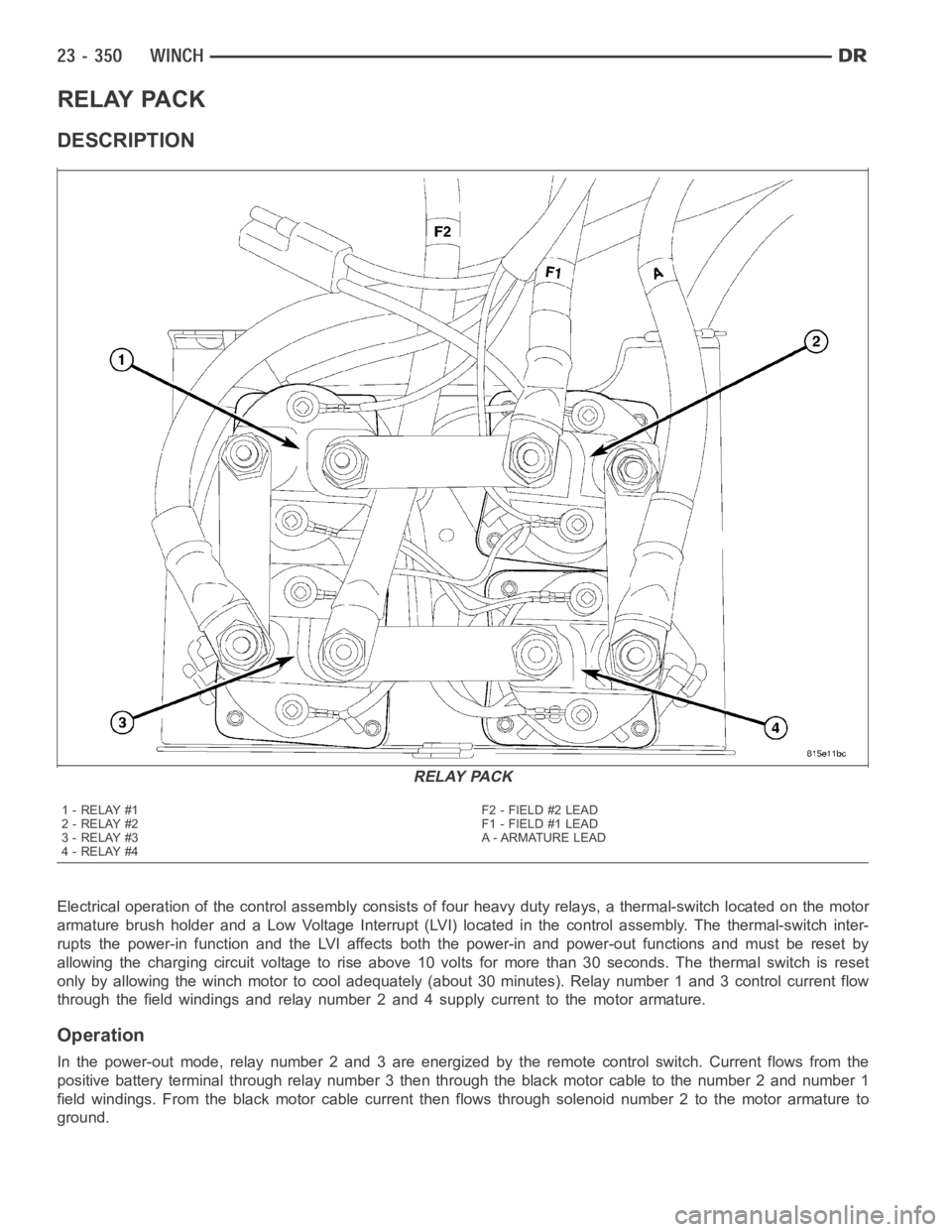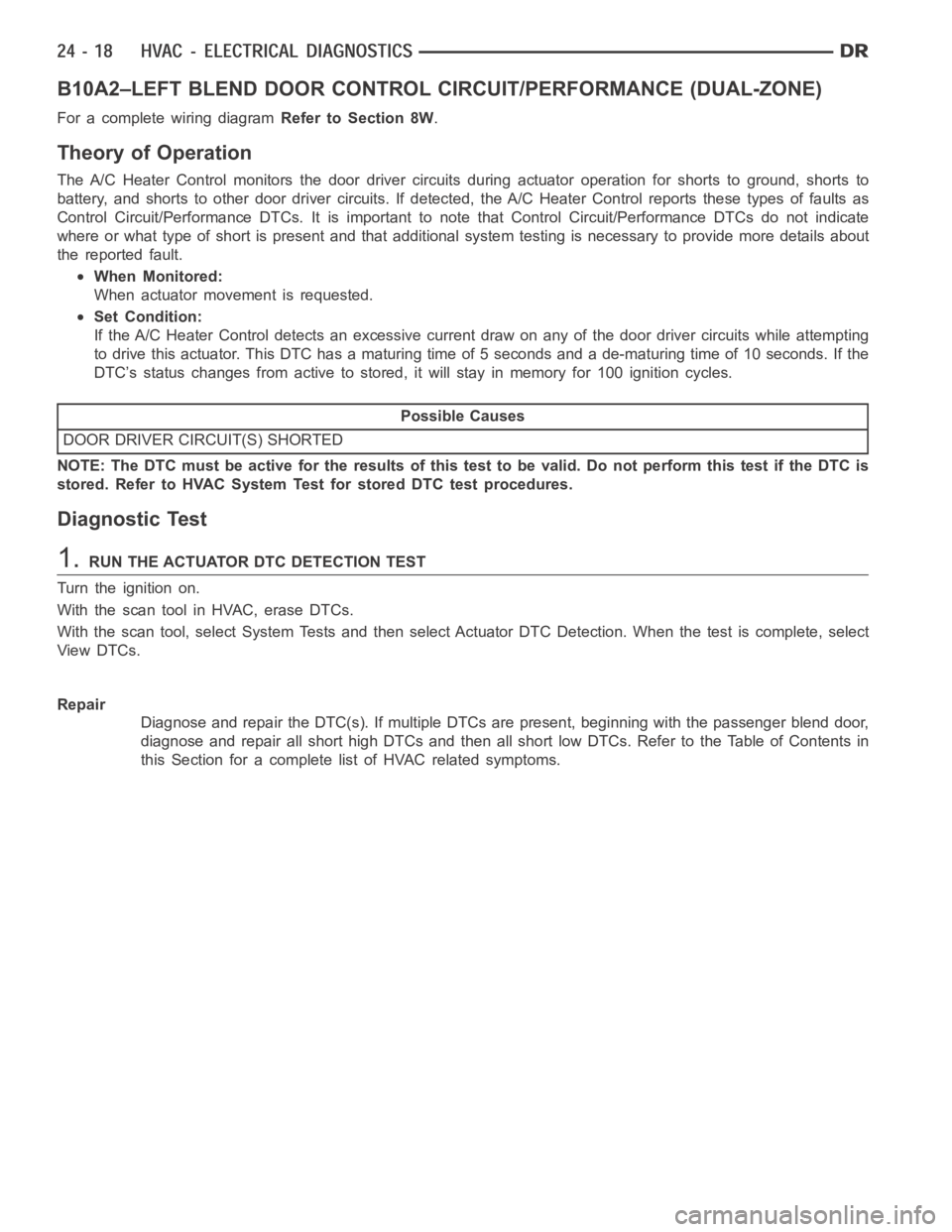Page 4673 of 5267
11. Install the lower frame bracket bolt (6) and nut (4).
12. Check and adjust the bumper alignment as nec-
essary (Refer to 23 - BODY/BODY STRUCTURE/
GAP AND FLUSH - SPECIFICATIONS).
13. Tighten the bolts and nuts to 95 Nꞏm (70 ft. lbs.).
14. Install the winch mounting bolts (1) and tighten to
41 Nꞏm (30 ft. lbs.)
15. Connect battery negative cable (3).
16. Verify the operation of the winch.
Page 4677 of 5267

MOTOR
DESCRIPTION
The winch is driven on one end by a two direction
electric motor powered by the vehicle electrical sys-
tem. The motor is internally protected by a thermal
switch that is activated when the motor gets too hot to
operate efficiently.
Winch motor controls consist of a relay pack mounted
to the motor, and a remote control connected to the
relay pack with a cord. The winch power source
cables are connected to the relay pack which in turn
feeds power to the winch motor through electrical
cable connections. The main function of the relay pack
is to allow the operator to switch the winch on and off
in both directions. The winch relay pack also includes
a Low Voltage Interrupt (LVI) used to prevent winch
operation in the event of battery power dropping below
10 volts.
REMOVAL
1. Remove the winch assembly (2). (Refer to 23 -
BODY/WINCH - REMOVAL)
MOTOR
1 - ARMATURE STUD/NUT 7 Nꞏm (60 in. lbs.)
2-MOTORBOLTS(2)9Nꞏm(82in.lbs.)
3 - MOUNTING BAND CLAMPS
4 - GROUND CABLE
5 - GROUND BOLT 14 Nꞏm (10 ft. lbs.)
6 - MOTOR COUPLER
7 - MOTOR DRIVE SHAFT
8 - FIELD STUDS/NUTS 7 Nꞏm (60 in. lbs.)
Page 4687 of 5267

RELAY PACK
DESCRIPTION
Electrical operation of the control assembly consists of four heavy duty relays, a thermal-switch located on the motor
armature brush holder and a Low Voltage Interrupt (LVI) located in the control assembly. The thermal-switch inter-
rupts the power-in function and the LVI affects both the power-in and power-out functions and must be reset by
allowing the charging circuit voltage to rise above 10 volts for more than 30 seconds. The thermal switch is reset
only by allowing the winch motor to cool adequately (about 30 minutes). Relay number 1 and 3 control current flow
through the field windings and relay number 2 and 4 supply current to the motor armature.
Operation
In the power-out mode, relay number 2 and 3 are energized by the remote control switch. Current flows from the
positive battery terminal through relay number 3 then through the black motor cable to the number 2 and number 1
field windings. From the black motor cable current then flows through solenoid number 2 to the motor armature to
ground.
RELAY PACK
1-RELAY#1
2-RELAY#2
3-RELAY#3
4-RELAY#4F2 - FIELD #2 LEAD
F1 - FIELD #1 LEAD
A - ARMATURE LEAD
Page 4688 of 5267
In power-in mode, relay number 1 and 4 are energized. Current again flows from the battery positive cable, but this
time current flows through solenoid number 1 then through field winding number 1. Current flowing in the reverse
direction through the field windings cause the motor to turn in the opposite direction. From the red motor cable
current then flows through relay number 4 to the black cable going to the motor armature to ground.
REMOVAL
1. Disconnect and isolate battery negative cable (3).
2. Remove the winch assembly (2). (Refer to 23 -
BODY/WINCH - REMOVAL)
Page 4689 of 5267
3. Remove the nut and disconnect the red battery
positive cable (1).
NOTE: Relay #4 shown, all others similar.
4. Remove the control wire nuts (1) and disconnect
the control wires (2) from each relay.
Page 4690 of 5267
INSTALLATION
NOTE: Relay #4 shown, all others similar.
1. Install the control wires (2) to all the relays and
install the nuts (1).
2. Tighten the nuts to 3 Nꞏm (25 in. lbs.).
3. Install the red battery positive cable (1) and install
the switch wire.
4. Install the nut and tighten to 10 Nꞏm (85 in. lbs.).
Page 4691 of 5267
5. Install the relay pack cover (1) and install the three
screws (2).
6. Install the winch assembly (2). (Refer to 23 -
BODY/WINCH - INSTALLATION)
7. Connect the battery negative cable (3) and verify
winch operation.
Page 4859 of 5267

B10A2–LEFT BLEND DOOR CONTROL CIRCUIT/PERFORMANCE (DUAL-ZONE)
For a complete wiring diagramRefer to Section 8W.
Theory of Operation
The A/C Heater Control monitors the door driver circuits during actuator operation for shorts to ground, shorts to
battery, and shorts to other door driver circuits. If detected, the A/C Heater Control reports these types of faults as
Control Circuit/Performance DTCs. It is important to note that Control Circuit/Performance DTCs do not indicate
where or what type of short is present and that additional system testing isnecessary to provide more details about
the reported fault.
When Monitored:
When actuator movement is requested.
Set Condition:
If the A/C Heater Control detects an excessive current draw on any of the door driver circuits while attempting
to drive this actuator. This DTC has a maturing time of 5 seconds and a de-maturing time of 10 seconds. If the
DTC’s status changes from active to stored, it will stay in memory for 100 ignition cycles.
Possible Causes
DOOR DRIVER CIRCUIT(S) SHORTED
NOTE:TheDTCmustbeactivefortheresultsofthistesttobevalid.Donotperform this test if the DTC is
stored. Refer to HVAC System Test for stored DTC test procedures.
Diagnostic Test
1.RUN THE ACTUATOR DTC DETECTION TEST
Turn the ignition on.
With the scan tool in HVAC, erase DTCs.
With the scan tool, select System Tests and then select Actuator DTC Detection. When the test is complete, select
View DTCs.
Repair
Diagnose and repair the DTC(s). If multiple DTCs are present, beginning with the passenger blend door,
diagnose and repair all short high DTCs and then all short low DTCs. Refer tothe Table of Contents in
this Section for a complete list of HVAC related symptoms.